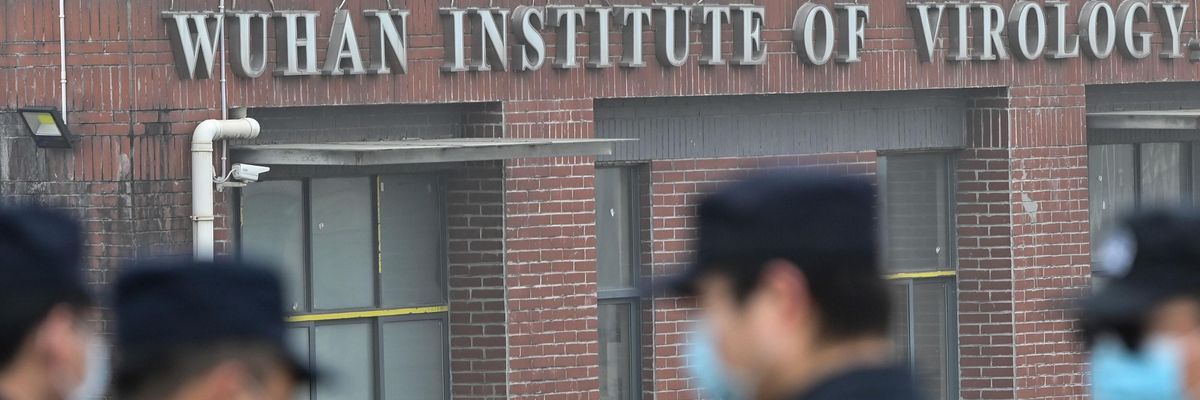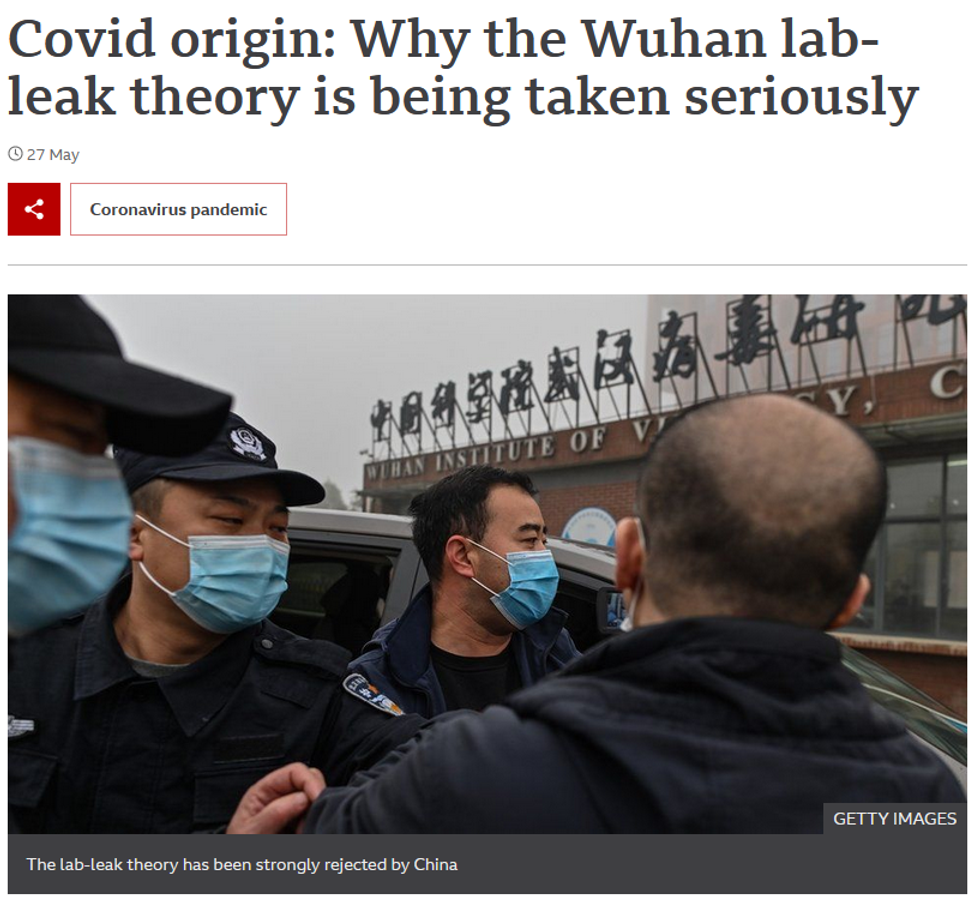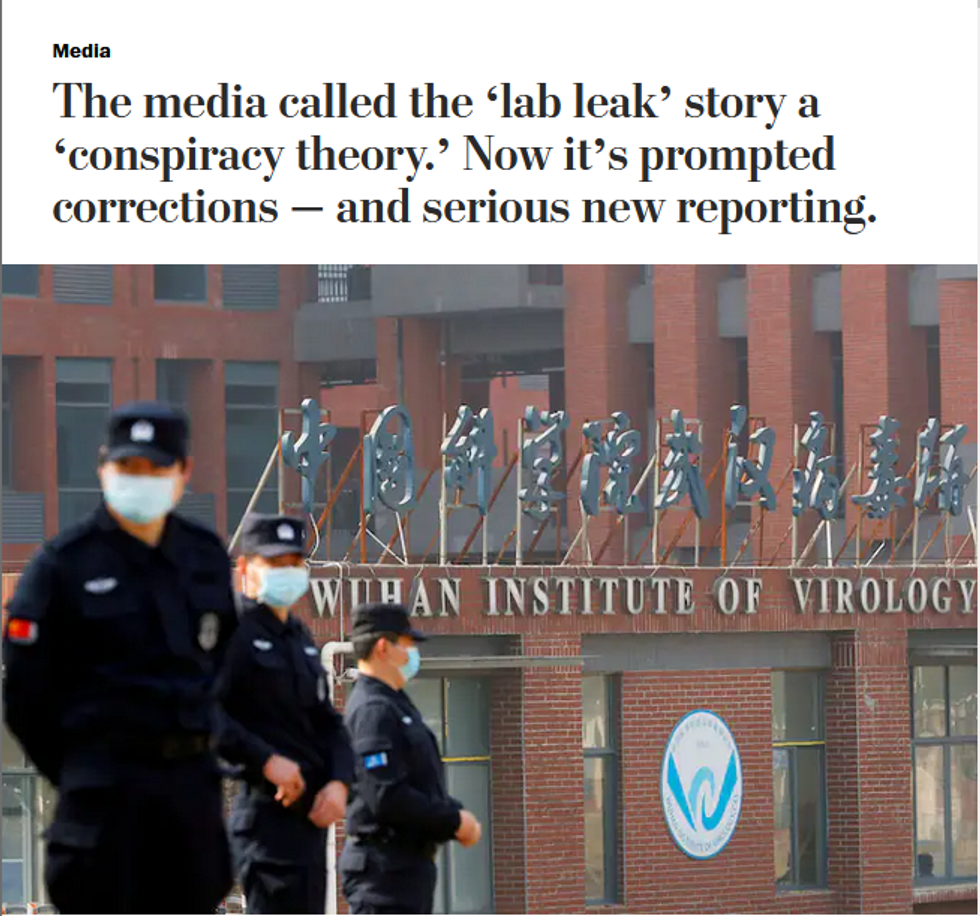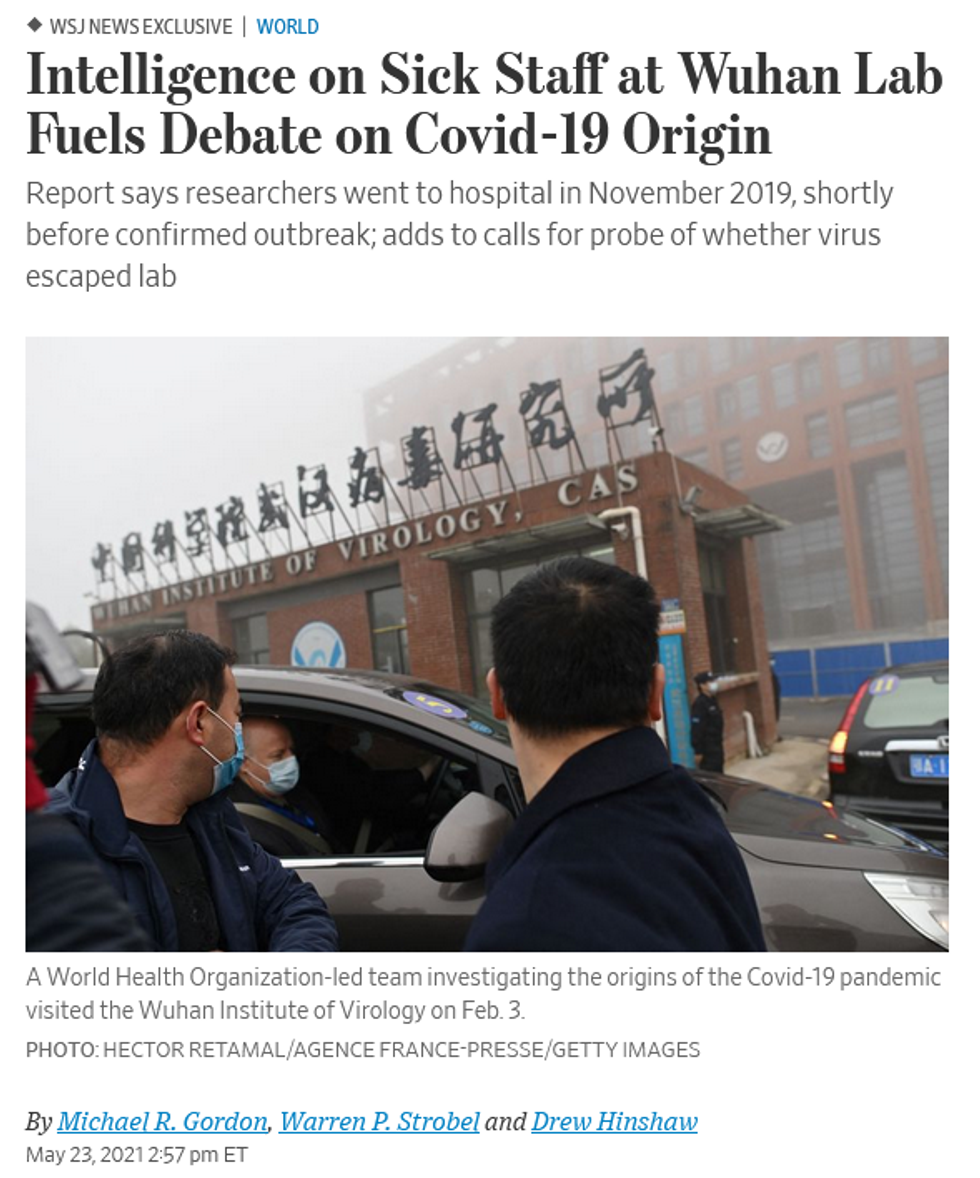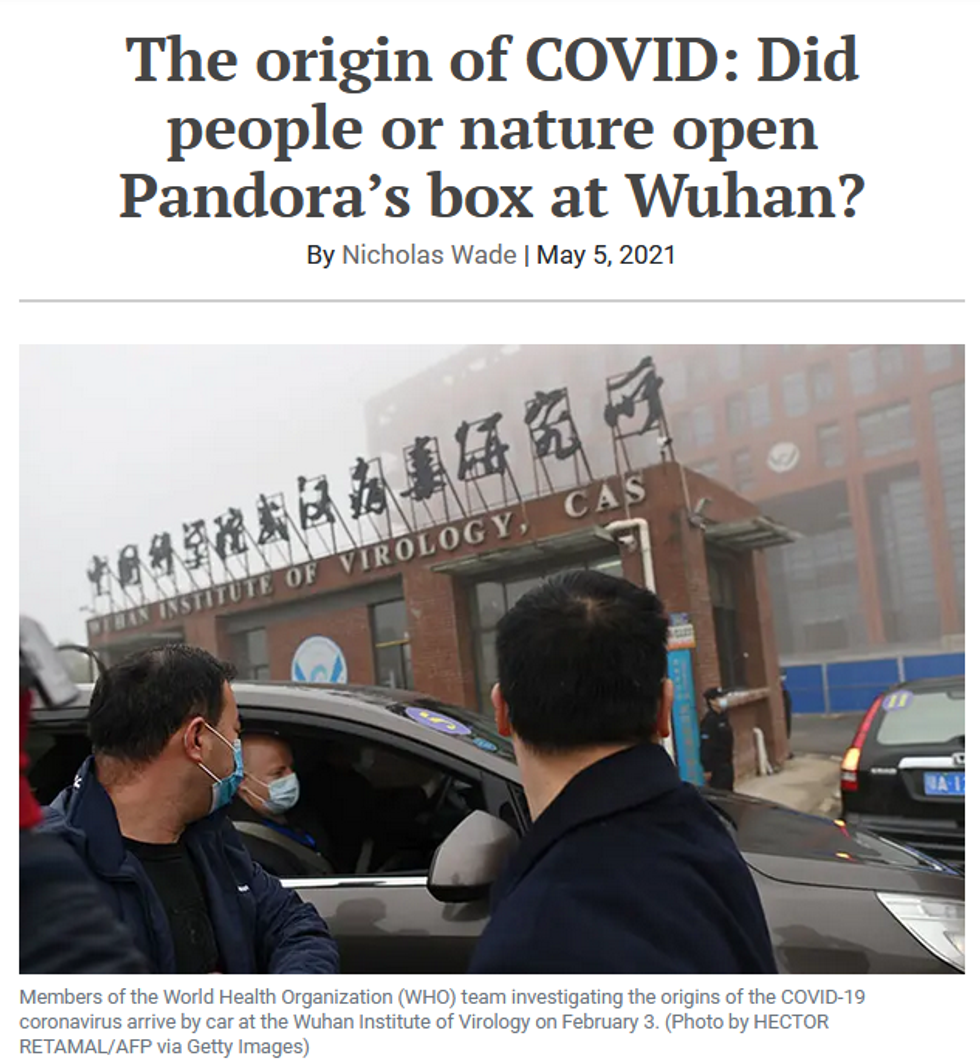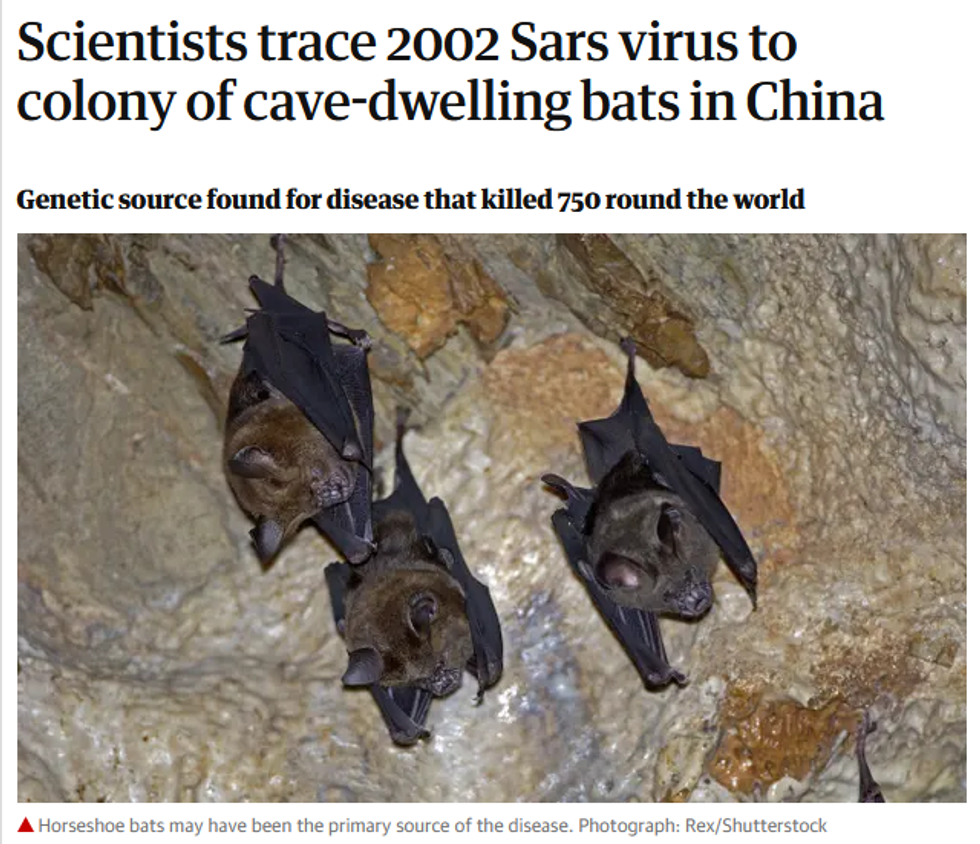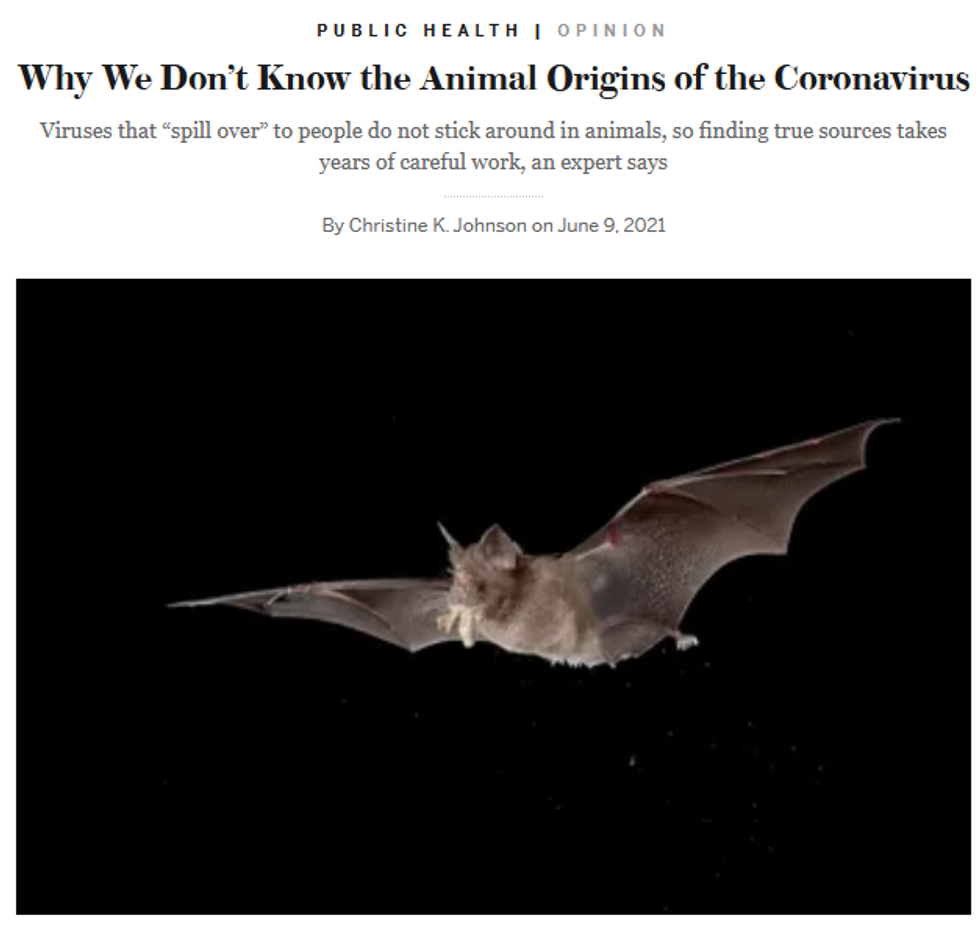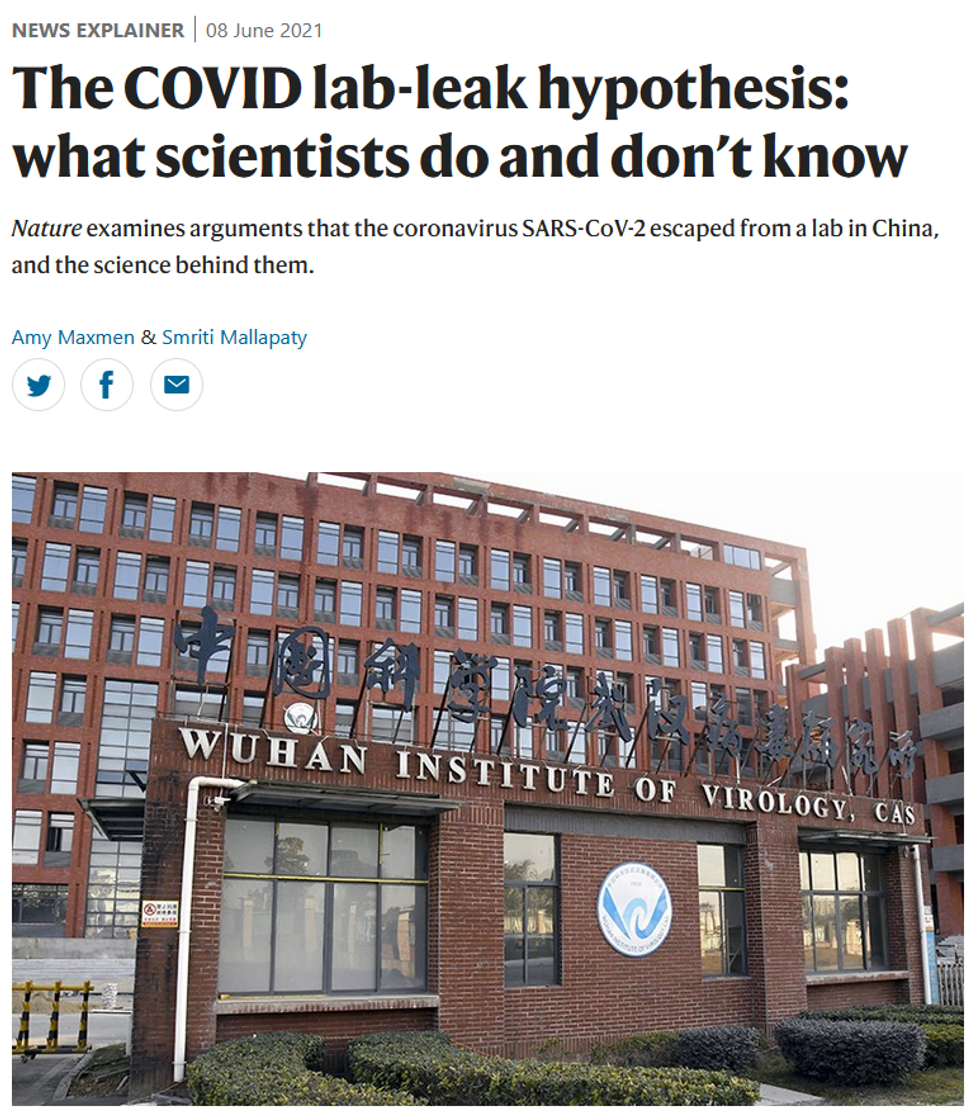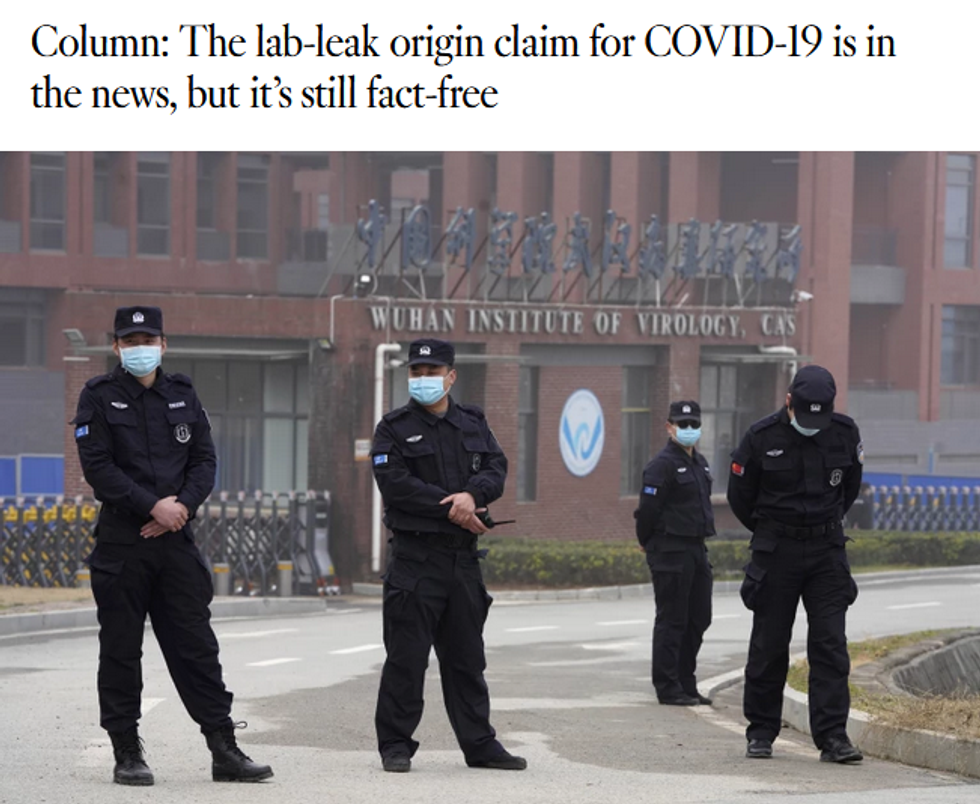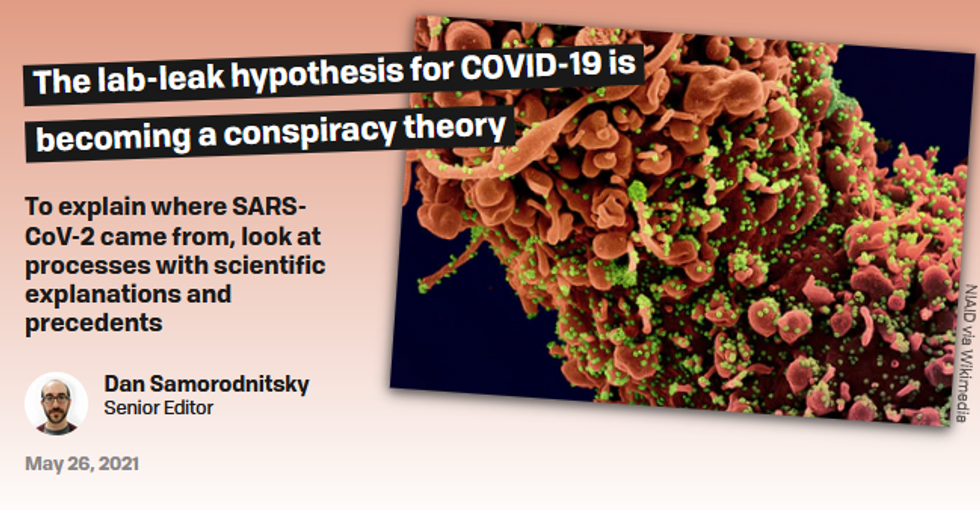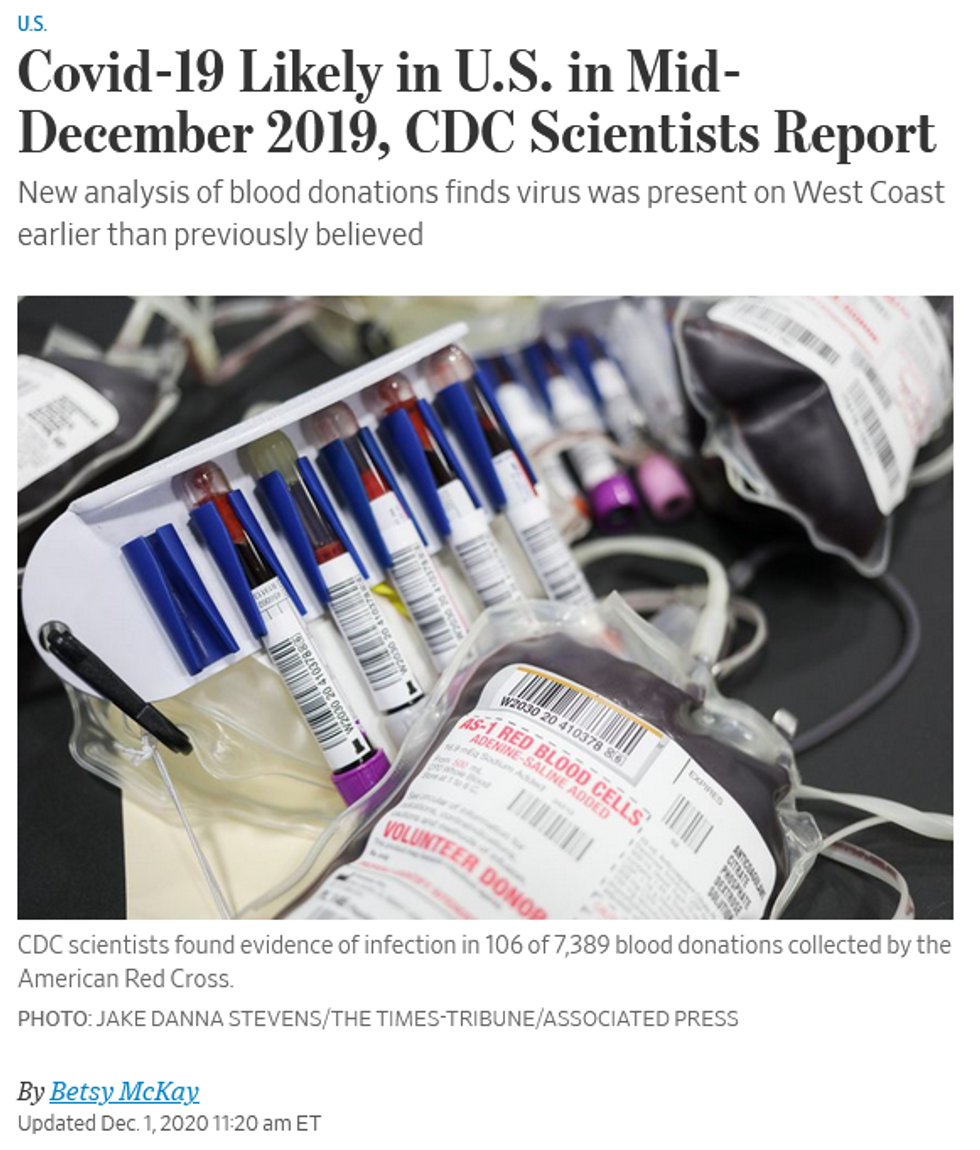While many Western media outlets (e.g., NBC, 5/4/20; BBC, 4/26/20) reported on the evidence-free speculations surrounding a potential lab leak of the SARS-CoV-2 virus from the Wuhan Institute of Virology (WIV) in China's Hubei province last year (FAIR.org, 4/17/20), it has never enjoyed as much mainstream credibility as it has in recent months.
Although several reports in 2020 uncritically parroted US officials like Sen. Tom Cotton and former Secretary of State Mike Pompeo, and discredited defectors like Yan Li-Meng, there were also many reports at the time disputing and dismissing their claims of a lab leak as a "conspiracy theory" (e.g., Vox, 3/12/20; AP, 12/17/20; Business Insider, 6/2/21).
Nowadays, an abundance of Western media reports purport to explain how the once-dismissed theory that SARS-CoV-2 came out of a Chinese lab in Wuhan has gained more credibility among journalists and the US public:
- Washington Post (5/25/21): "Timeline: How the Wuhan Lab-Leak Theory Suddenly Became Credible"
- New Yorker (5/27/21): "The Sudden Rise of the Coronavirus Lab-Leak Theory"
- ABC (6/14/21): "Nature-Based or Lab Leak? Unraveling the Debate Over the Origins of Covid-19"
- New York (6/3/21): "The Groupthink That Produced the Lab-Leak Failure Should Scare Liberals"
Despite the sudden media enthusiasm for the lab leak theory, there remains as little compelling evidence that the virus escaped from a Chinese lab as there always has been (FAIR.org, 10/6/20).
Taking cues from US

The BBC's piece (5/27/21) explaining "why the Wuhan lab-leak theory is being taken seriously" begins by citing "reports swirling around the US media."
But why the sudden shift? BBC's "Covid Origin: Why the Wuhan Lab-Leak Theory Is Being Taken Seriously" (5/27/21) reported that interest in the possibility of a Wuhan lab leak resurfaced because
reports swirling around the US media have raised fresh concerns over the lab-leak theory. And some scientists who were once skeptical of the idea have expressed fresh openness to it.
NPR's "Why Much of the Media Dismissed Theories That Covid Leaked From Lab" (6/3/21) explained that the lab leak theory was "dismissed and ridiculed by the media" because its main sources were "former President Donald Trump and former Secretary of State Mike Pompeo," who "were pushing this idea, citing intelligence they simply wouldn't release." NPR added that the shift in coverage was due to a group of scientists publishing a statement arguing that the lab leak theory needs to be investigated, even if it "may not be likely," and, more tellingly, simply because "President Biden said, look, let's investigate this, matter of national security."
Poynter (6/17/21) also reported that Biden's decision to have US intelligence agencies investigate Covid origins have prompted news outlets, factcheckers and Facebook to change their posture towards the lab leak theory:
As a result, some news outlets have revised or corrected some of their prior reporting. Facebook reversed its ban. PolitiFact removed its fact check from its database, but archived it "for transparency" and added an editor's note.
It's certainly true that people like Trump and Pompeo are notorious for being shameless liars, and blatantly promoted the lab leak theory in a cynical attempt to scapegoat China for the US's disastrous handling of the pandemic (FAIR.org, 3/24/20). However, NPR's statement implies that the lab leak theory should be taken more seriously in part because President Joe Biden is perceived as a more credible source, despite his own documented history of serial lying (FAIR.org, 1/22/20; Intercept, 3/9/20).
Letter not an endorsement

The "serious new reporting" cited by the Washington Post (6/10/21) comes mainly from a eugenicist and the reporter who helped make the phrase "aluminum tubes" famous.
Like NPR, the Washington Post's "The Media Called the 'Lab Leak' Story a 'Conspiracy Theory.' Now it's Prompted Corrections--and Serious New Reporting" (6/10/21) pointed to the publication of a letter by 18 scientists in Science (5/14/21) as one of the main reasons for "a kind of tidal change" in coverage. That letter argued that "theories of accidental release from a lab and zoonotic spillover both remain viable":
We must take hypotheses about both natural and laboratory spillovers seriously until we have sufficient data. A proper investigation should be transparent, objective, data-driven, inclusive of broad expertise, subject to independent oversight and responsibly managed to minimize the impact of conflicts of interest. Public health agencies and research laboratories alike need to open their records to the public. Investigators should document the veracity and provenance of data from which analyses are conducted and conclusions drawn, so that analyses are reproducible by independent experts.
What media outlets like Newsweek (5/14/21) reporting on the letter often failed to make clear is that scientists calling for an investigation of the lab leak theory is not the same as suggesting that it is probable. Most scientists currently think that Covid-19 has a natural origin, because there is a well-documented history of natural spillovers leading to most disease outbreaks (like HIV, MERS, Zika and Ebola), and of scientists warning of the increasing likelihood of pandemics due to the climate crisis and human activity altering terrestrial and marine environments, which increases the nature and frequency of human contact with wildlife harboring diseases.
Some of the signatories to that letter have taken pains to emphasize that they are not endorsing the lab leak theory, and some are even highly skeptical of the hypothesis (LA Times, 6/3/21). Their relatively uncontroversial goal was merely to urge the World Health Organization (WHO) to devote more effort to determine the origin, whatever it might be, before expressing a categorical opinion.
Iraqi WMD-style reporting

The uncritical retailing of convenient intelligence claims is highly reminiscent of Michael Gordon's notorious Iraq War work. Co-author Warren Strobel, on the other hand, once knew better.
The Washington Post wrote that another "tentative bit of new information to chew on" responsible for the shift in coverage was the publication of a dubious report from the Wall Street Journal (5/23/21). The paper cited anonymous "current and former officials" for the claim that "three researchers from China's Wuhan Institute of Virology became sick enough in November 2019 that they sought hospital care," with "symptoms consistent with both Covid-19 and common seasonal illness."
As FAIR (3/29/16, 7/6/16, 1/11/21) has repeatedly documented, anonymous sources are notoriously unreliable, often with nefarious agendas. Besides relying on unnamed officials, another issue with the Journal report is that its lead author, Michael R. Gordon, co-authored (with Judith Miller) the notorious New York Times report (9/8/02) that was perhaps the single piece of journalism most responsible for deceiving the nation about Saddam Hussein's imaginary weapons of mass destruction (WSWS, 6/1/21).
Both the Journal and the Post are careful to note that the report should not be taken as an indisputable fact, even though that article was cynically seized on and misrepresented as evidence by some lab leak proponents. Yet outlets like CNN (5/24/21) treated the Journal's dubious reporting as fact when it asserted that a "US intelligence report found that several researchers at China's Wuhan Institute of Virology fell ill in November 2019 and had to be hospitalized." And the Biden administration's directive to intelligence agencies to "redouble their efforts" to determine Covid-19's origin happened mere days after the Journal report was published.
The Journal report doesn't specify whether the WIV researchers had Covid-19, or whether their illnesses were even linked to the lab--as opposed to getting sick outside the lab--and WIV director Yuan Zhiming has disputed the Journal's reporting (Global Times, 5/24/21): "Those claims are groundless. The lab has not been aware of this situation [of sick researchers in autumn 2019], and I don't even know where such information came from."
Dr. Shi Zhengli, the WIV's famed virologist responsible for scientific breakthroughs in studying coronaviruses, has challenged US intelligence agencies to produce the names of the supposedly sick WIV researchers to verify their claims.
If the Journal report is false, it wouldn't be the first time similar claims from anonymous US officials turned out to be untrue. A sensationalist ABC report (4/8/20) based entirely on anonymous sources claimed that the US National Center for Medical Intelligence (NCMI) possessed a report purporting to show that the White House was informed about the pandemic in November 2019 (suggesting China's leadership was aware of an out-of-control disease outbreak and was hiding crucial information from other countries). It was later debunked by the NCMI's director, who testified that "no such NCMI product exists."
Even if the hospital visit occurred, this still is not evidence the WIV had SARS-CoV-2 in its lab, and a mere alleged hospital visit shouldn't necessarily be interpreted as evidence the three supposed researchers were suffering from a severe illness. People in China often visit hospitals to see specialists for common ailments like fevers and headaches--instead of going to a private doctor's office or community clinic--because most Chinese doctors in urban areas practice in public hospitals (New York Times, 9/30/18).
Specialist in pseudo-science

Nicholas Wade's book attributing cultural differences to genetics brought rebukes from scientists who study genes; "Our findings do not even provide a hint of support in favor of Wade's guesswork," said one (Science, 8/8/14).
The other major event the Washington Post cites as responsible for the "tidal change" in coverage was the publication of "a lengthy review of the known scientific evidence about the lab theory by Nicholas Wade," described as "a veteran science correspondent formerly with the New York Times."
Notable left-wing journalists like Thomas Frank (Guardian, 6/1/21) and Jonathan Cook (6/1/21) have cited Wade's article as having "dynamited" their "complacency" on the debate, with Cook claiming that it "blew open the doors that had been kept tightly shut on the lab-leak hypothesis."
Those who cite Wade rarely mention the track record that makes him a highly dubious source (FAIR.org, 7/2/14). He has a history of misrepresenting research to promote pseudo-scientific falsehoods, like using "genes" to explain national differences in cultures and economic standing (Science, 8/8/14).
Although I previously cited scientific arguments for a natural spillover and debunked older corporate media claims for "evidence" of a Wuhan lab leak (like Post columnist Josh Rogin's misrepresentation of scientific research, and a US diplomatic cable about "safety issues" at the WIV) in another article (FAIR.org, 10/6/20), it's still worth addressing several of Wade's purportedly scientific arguments in his more than 11,000-word, non-peer-reviewed Medium article (5/2/21) that was later reprinted on the Bulletin of the Atomic Scientists's website (5/5/21).
Where the viruses are

Despite the credibility conferred by the Bulletin of the Atomic Scientists' reprint (5/5/21), Nicholas Wade's influential piece on the lab leak theory includes numerous leaps of scientific logic.
To start with, Wade makes a common mistake among lab leak proponents by assuming that the presence of a lab studying coronaviruses in an area where the outbreak of Covid-19 was first detected is an inherently suspicious coincidence:
For the lab escape scenario, a Wuhan origin for the virus is a no-brainer. Wuhan is home to China's leading center of coronavirus research where, as noted above, researchers were genetically engineering bat coronaviruses to attack human cells. They were doing so under the minimal safety conditions of a BSL2 lab. If a virus with the unexpected infectiousness of SARS2 had been generated there, its escape would be no surprise.
As several virologists have explained, the WIV specializes in coronavirus research because many coronaviruses have been found in and around China (around 400 new strains of coronaviruses have been discovered in bats there, and zoonotic spillovers are more common than one might think), and the WIV's proximity to the first detected Covid-19 outbreak is not inherently suspicious (Nature, 6/8/21):
Virology labs tend to specialize in the viruses around them, says Vincent Munster, a virologist at the Rocky Mountain Laboratories, a division of the National Institutes of Health, in Hamilton, Montana. The WIV specializes in coronaviruses because many have been found in and around China. Munster names other labs that focus on endemic viral diseases: influenza labs in Asia, haemorrhagic fever labs in Africa and dengue fever labs in Latin America, for example. "Nine out of ten times, when there's a new outbreak, you'll find a lab that will be working on these kinds of viruses nearby," says Munster.
Researchers note that a coronavirus outbreak in Wuhan isn't surprising, because it's a city of 11 million people in a broader region where coronaviruses have been found. It contains an airport, train stations and markets selling goods and wildlife transported there from around the region--meaning a virus could enter the city and spread rapidly.
It makes sense that there would be a laboratory researching coronaviruses in southern China--where a lot of the cutting-edge research on coronaviruses is being conducted--because that places scientists closest to where coronaviruses are often found in nature.
Outbreaks' distant sources

After searching for 15 years, scientists found a genetic match for the virus that caused the 2002 SARS outbreak in a cave hundreds of miles from where that outbreak first occurred (Guardian, 12/9/17).
Wade makes another geography-related error when he claims that it's "a stretch" for the pandemic to "break out naturally outside Wuhan" and make its first appearance there without "leaving any trace" through an intermediate animal host. He also claims that a direct spillover to Wuhan from horseshoe bats (which are a natural reservoir for beta-coronaviruses like SARS-CoV-2) is "unlikely" because the two closest known relatives of the SARS-CoV-2 virus were collected from bats living in caves in Yunnan province, 1,500 kilometers away (about 930 miles), when their range is supposedly only 50 kilometers (about 30 miles).
But Wade failed to note that there is precedent for the first people detected with a beta-coronavirus infection living far from the bats of Yunnan province. In 2002, Sudden Acute Respiratory Syndrome (SARS) originated from Yunnan bats, but the first outbreak in humans was recorded in Foshan, in China's Guangdong province, nearly 900 miles away (approximately 1,450 kilometers). Scientists suspected that the SARS-causing beta-coronavirus (SARS-CoV-1) had jumped from bats to humans through an intermediate host, but could not deduce how it appeared on a farm in Foshan (Business Standard, 6/15/21).
Yet, more than a decade after the SARS outbreak of 2002, WIV researchers discovered that villagers near bat-ridden caves in Yunnan province had high levels of SARS antibodies (which means they had been exposed to SARS-CoV-1) without necessarily ever having been sick. While scientists still aren't exactly sure how SARS traveled that distance, they are fairly certain SARS originated in those bat caves before passing onto a mammal host to infect humans much farther away.
In a hypothetical Covid-19 scenario, if the bats in Yunnan province are the initial source of SARS-CoV-2 (the virus that causes Covid-19), and if Wuhan is where the pandemic originated among humans, Wuhan being relatively far away from Yunnan doesn't necessarily make the zoonotic spillover hypothesis less likely.
Origins hard to pinpoint

"Confirming the circumstances and key participants involved in the early emergence of an infectious disease is...difficult to track and even more difficult to prove," Scientific American (6/9/21) noted.
Another common tendency among lab leak proponents like Wade is misrepresentation of what is reasonable to expect from scientific investigations searching for the animal source(s) of a novel disease outbreak. Wade misleads his audience by implying it is easy to quickly find animal hosts for viruses, citing how the intermediary host for SARS was found in four months, and the host of MERS within nine months. He contrasts that with Chinese researchers not finding either the original bat population for SARS-CoV-2 or an intermediary host population after 15 months.
In reality, it is very difficult to pinpoint the animal sources that cause pandemics. For some viruses, the animal sources are only implicated after years or decades of large-scale international investigations. Investigations into an animal source that immediately follow a viral emergence event face the additional difficulty that most viruses of interest only infect animal hosts for a matter of days--and a preceding animal outbreak has often already peaked before an outbreak among humans, leaving few animals still infected (Scientific American, 6/9/21).
Wade is being especially manipulative by only citing how long it took to discover SARS' intermediate host, but omitting that it took scientists 15 years to find evidence that the SARS virus was originally at home in bats. The animal host for Ebola is still unknown, even though the first Ebola outbreak occurred in 1976 (Nature, 5/27/21).
It is not surprising that scientists haven't discovered the animal sources yet, and it would still not be surprising if scientists never find any of the direct sources, because it is a very difficult process, with searches for intermediary hosts for many viruses often being unsuccessful. Wade is wrong to conclude that "the more months pass without the natural emergence theory gaining a shred of supporting evidence, the less plausible it may seem," as though scientists ordinarily pinpoint the natural origin of pandemics as a matter of course.
Viral structure no 'smoking gun'

The viral feature deemed suspicious by Wade "probably evolved multiple times because it provides an evolutionary advantage," Nature (6/8/21) reported.
Wade also misleads his audience when he notes that SARS-CoV-2 is the only SARS-related beta-coronavirus that "possesses a furin cleavage site" (a feature that helps the virus enter cells):
It possessed an unusual enhancement, a furin cleavage site, which is not possessed by any other known SARS-related beta-coronavirus, and this site included a double arginine codon also unknown among beta-coronaviruses.
He omits that many other coronaviruses also have furin cleavage sites, including ones that cause common colds. Virologists Angela Rasmussen and Stephen Goldstein (Washington Post, 6/4/21) argued that SARS-CoV-2's furin cleavage site actually demonstrates the opposite of what Wade purports it does:
Another key feature often cited as evidence of laboratory origin is the furin cleavage site, where the spike protein is cut in half to "activate" viral material for entry into cells. The viruses most closely related to SARS-CoV-2 don't have this site, but many others do, including other human coronaviruses. The furin site of SARS-CoV-2 has odd features that no human would design. Its sequence is suboptimal, meaning its cleavage by the enzyme furin is relatively inefficient. Any skilled virologist hoping to give a virus new properties this way would insert a furin site known to be more efficient. The SARS-CoV-2 site has more of the hallmarks of sloppy natural evolution than a human hand. Indeed, a timely analysis last year showed convincingly that it is a product of genetic recombination, a natural feature of coronavirus replication and evolution.
As further "evidence" of the uniqueness of SARS-CoV-2's features indicating an engineered virus, Wade and other articles promoting the lab leak theory (e.g., Vanity Fair, 6/3/21) also cited the eminent virologist David Baltimore's hyperbolic remarks on SARS-CoV-2's peculiar double CGG combination of nucleotides coding for the arginine amino acid in the furin cleavage site, as pointing to a human engineered virus:
"When I first saw the furin cleavage site in the viral sequence, with its arginine codons, I said to my wife it was the smoking gun for the origin of the virus," said David Baltimore, an eminent virologist and former president of CalTech. "These features make a powerful challenge to the idea of a natural origin for SARS2," he said.
However, Kristian Andersen pointed out in response to Baltimore that while it's true that CGG is less common than other codons for arginine, the CGG codon is also found outside the furin cleavage site in the SARS-CoV-2 genome, and the genetic sequences that include the CGG codon found in SARS-CoV-2 are also found in other coronaviruses. Baltimore subsequently retracted his "smoking gun" claim (Nature, 6/8/21; LA Times, 6/8/21).
Andersen, one of the most vocal defenders of the natural emergence theory of Covid-19, has been the subject of recent controversy following the publication of an early email exchange he had with Anthony Fauci, the director of the National Institute of Allergy and Infectious Diseases (NIAID). The emails showed Andersen contemplating whether SARS-CoV-2 was engineered before changing his mind days later, and co-authoring an influential Nature study (3/17/20) that found no reason to "believe any type of laboratory-based scenario is plausible." Andersen has since clarified that his early email exchanges with Dr. Fauci occurred before he had conducted research that caused him to reject his preliminary hypothesis that SARS-CoV-2 was engineered, because he found that the features which initially looked unusual were later identified in related coronaviruses (New York Times, 6/14/21).
Climate denial rhetoric

"There is no evidence -- not a smidgen -- for the claim that Covid-19 originated in a laboratory in China or anywhere else, or that the China lab ever had the virus in its inventory," writes Michael Hiltzik (LA Times, 6/3/21).
This is a nonexhaustive rebuttal to Wade's article; scientists and others have written their own critiques of Wade's article (Forbes, 5/20/21; LA Times, 6/3/21). But one disturbing trend among lab leak proponents like Wade is how often they engage in rhetoric similar to climate change deniers, insinuating that the only reason their minority view isn't as accepted is due to widespread corruption among scientists and left-wing media bias:
They [virologists] have common interests in seeking funds from governments and in not being overburdened with safety regulations.... Virologists knew better than anyone the dangers of gain-of-function research [i.e., deliberately altering organisms or viruses to gain more pathogenic characteristics]. But the power to create new viruses, and the research funding obtainable by doing so, was too tempting.
Another reason, perhaps, is the migration of much of the media toward the left of the political spectrum. Because President Trump said the virus had escaped from a Wuhan lab, editors gave the idea little credence.
The claim that dominant media in the US are on "the left of the political spectrum" should serve as a warning not to rely on Wade's critical thinking abilities. Reporting on the coronavirus, corporate media have reflected the anti-China lean that is common across the US foreign policy establishment (FAIR.org, 5/15/20, 1/29/21, 4/8/21).
His assertion about scientific conflicts of interest deserves perhaps a little more attention. One of the people Wade singles out for criticism is zoologist Peter Daszak, president of the EcoHealth Alliance, for organizing and drafting the widely circulated Lancet open letter (2/19/20) that condemned "conspiracy theories suggesting that Covid-19 does not have a natural origin," without disclosing the fact that EcoHealth Alliance had funded coronavirus research at the WIV. Wade noted that if SARS-CoV-2 did escape from research his institution funded, Daszak would be among those who might be held culpable, yet he didn't disclose this conflict of interest in that letter.
However, if it's theoretically true that bad actors like Trump and Pompeo could nevertheless be correct about pandemic origins, then the logic cuts both ways: Researchers like Daszak can still be correct about Covid-19 having natural origins, despite whatever conflicts of interests they may have.
'Can't be ruled out' a weak claim

Dan Samorodnitsky (Massive Science, 5/26/21) "It's naive at best and violent gaslighting at worst to pretend that supporting an evidence-free hypothesis that clearly adds fuel to the idea that China inflicted Covid-19 upon the world, that they did this to us, is noble scientific dispassion."
A few final notes on logic. One fallacious mode of argumentation lab leak proponents use is citing a lengthy list of incidents where viruses are known to have leaked from labs around the world, while glossing over the lack of any evidence that the WIV was in possession of SARS-CoV-2 before the Wuhan outbreak, a necessary precondition for a Covid-19 lab leak.
If one assumes without evidence that WIV was hiding its pre-outbreak possession of SARS-CoV-2, and lying about it afterwards--the kind of leap that is the hallmark of a conspiracy theory--one still has to ask what foreign lab incidents (Independent Science News, 5/5/20) have to do with whether or not the virus escaped from the WIV to trigger the pandemic. Dr. Shi Zhengli has insisted that there haven't been any pathogen leaks or personnel infections at the WIV prior to recent lab leak speculations.
If the point of recounting a list of lab leak incidents is merely to point out something as trivial as a lab leak being a "possibility" that "can't be ruled out," this is also irrelevant. Proponents of a natural origin theory for Covid-19 never argue that a Wuhan lab leak is "impossible" or "inconceivable." As Dan Samorodnitsky, senior editor at Massive Science (5/26/21) (who has a PhD in biochemistry) pointed out:
If the question is "are both hypotheses possible?" the answer is yes. Both are possible. If the question is "are they equally likely?" the answer is absolutely not. One hypothesis requires a colossal cover-up and the silent, unswerving, leak-proof compliance of a vast network of scientists, civilians and government officials for over a year. The other requires only for biology to behave as it always has, for a family of viruses that have done this before to do it again. The zoonotic spillover hypothesis is simple and explains everything. It's scientific malpractice to pretend that one idea is equally as meritorious as the other. The lab-leak hypothesis is a scientific deus ex machina, a narrative shortcut that points a finger at a specific set of bad actors.
Covid's uncertain origin

Evidence that Covid-19 was circulating around the world before it was identified in Wuhan (e.g., Wall Street Journal, 12/1/20) should unsettle confident assumptions about where the virus originated.
It's also important to note that it hasn't been proven that Wuhan is the origin of the pandemic, as one should not conflate Wuhan being the place where Covid-19 was first detected, with Wuhan being the origin of the pandemic. It's certainly possible that Wuhan is the origin of the outbreak, but there have been numerous reports of the virus possibly circulating outside China in places like Italy, France, Spain, Brazil and the US before or around the same time the outbreak was first detected in Wuhan in December 2019, which adds to growing evidence Covid-19 may have been present outside of China earlier than previously known (Wall Street Journal, 5/5/20, 12/1/20; Conversation, 6/28/20; Telesur, 7/3/20; CNBC, 11/15/20; New York Times, 6/15/21).
Although these reports don't necessarily mean Covid-19 originated in any of those countries (as they need to be reanalyzed to confirm they're not false positives), the WHO team which visited China this year has recommended broadening the search for the virus's origin outside China (Nature, 2/10/21). If Wuhan is not the origin of the Covid-19 pandemic, then the Wuhan lab leak theory utterly collapses.
Scientists rarely make absolute declarations on whether a scenario is impossible, and that is a good indicator of professionalism. However, scientists have also noted the difficulties in communicating nuanced views to the public, as many credulous lab leak proponents will treat scientists' mere acknowledgement that a lab leak is not impossible as more significant than it really is. Merely saying that something "can't be ruled out" is not a serious argument that a lab leak occurred.
It is important to avoid a politically charged scenario analogous to climate change skepticism, where significant portions of the US population reject the views of most scientists due to the media's false balance of opposing views.
